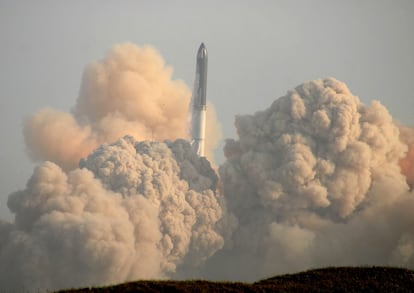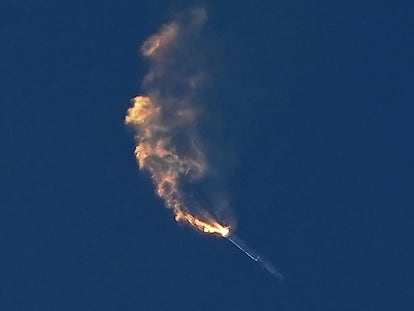Environmental groups sue the FAA over SpaceX rocket launch in Texas
The groups are suing over what they consider to be the FAA’s failure to fully consider the environmental impacts of the Starship program near Boca Chica Beach

Wildlife and environmental groups sued the Federal Aviation Administration on Monday over SpaceX’s launch last month of its giant rocket from Texas. SpaceX’s Starship soared 24 miles (39 kilometers) high before exploding over the Gulf of Mexico on April 20. The rocket’s self-destruct system caused the nearly 400-foot (120-meter) rocket to blow up, as it spun out of control just minutes into the test flight.
An attorney for the Center for Biological Diversity, one of the plaintiffs, said the groups are suing over what they consider to be the FAA’s failure to fully consider the environmental impacts of the Starship program near Boca Chica Beach in South Texas. They asked the court to throw out the five-year license the FAA granted to SpaceX.
The FAA declined comment, noting it doesn’t comment on ongoing litigation. The agency is overseeing the accident investigation and has ordered all SpaceX Starships grounded until it’s certain that public safety will not be compromised.
Over the weekend, SpaceX founder and chief executive, Elon Musk, said his company could be ready to launch the next Starship in six to eight weeks with the FAA’s OK.
No injuries or significant damage to public property were reported from any of the rocket wreckage or flying pad debris. A large crater was carved into the concrete pad, as most of the rocket’s 33 main engines ignited at liftoff.
The launch pad is on a remote site on the southernmost tip of Texas, just below South Padre Island, and about 20 miles from Brownsville.
The U.S. Fish and Wildlife Service reported last week that large concrete chunks, stainless steel sheets, metal and other objects were hurled thousands of feet (hundreds of meters) from the pad. In addition, a plume of pulverized concrete sent material up to 6.4 miles (4 kilometers) northwest of the pad, the service noted.
It was the first launch of a full-size Starship, with the spacecraft on top of the huge booster rocket. The company plans to use it to send people and cargo to the moon and, ultimately, Mars. NASA wants to use Starship to ferry astronauts to the lunar surface as soon as 2025.
Joining the Center for Biological Diversity in the lawsuit, filed in U.S. District Court in Washington, are the American Bird Conservancy, Surfrider Foundation, Save RGV (Rio Grande Valley) and the Carrizo/Comecrudo Nation of Texas.
“It’s vital that we protect life on Earth even as we look to the stars in this modern era of spaceflight,” the Center for Biological Diversity’s Jared Margolis said in a statement. “Federal officials should defend vulnerable wildlife and frontline communities, not give a pass to corporate interests that want to use treasured coastal landscapes as a dumping ground for space waste.”
Over the weekend, Musk said changes are being made at the launch pad to avoid what he called a dust storm and “rock tornado” at the next launch.
“To the best of our knowledge there has not been any meaningful damage to the environment that we’re aware of,” Musk said.
Musk has promised to make improvements to the next Starship before it flies. The self-destruct system will need to be modified, he said, so that the rocket explodes immediately — not 40 seconds or so afterward, as was the case with this inaugural run, he said.
His remarks were made to a subscriber-only Twitter chat Saturday night that was later posted by others online.
Sign up for our weekly newsletter to get more English-language news coverage from EL PAÍS USA Edition
Tu suscripción se está usando en otro dispositivo
¿Quieres añadir otro usuario a tu suscripción?
Si continúas leyendo en este dispositivo, no se podrá leer en el otro.
FlechaTu suscripción se está usando en otro dispositivo y solo puedes acceder a EL PAÍS desde un dispositivo a la vez.
Si quieres compartir tu cuenta, cambia tu suscripción a la modalidad Premium, así podrás añadir otro usuario. Cada uno accederá con su propia cuenta de email, lo que os permitirá personalizar vuestra experiencia en EL PAÍS.
¿Tienes una suscripción de empresa? Accede aquí para contratar más cuentas.
En el caso de no saber quién está usando tu cuenta, te recomendamos cambiar tu contraseña aquí.
Si decides continuar compartiendo tu cuenta, este mensaje se mostrará en tu dispositivo y en el de la otra persona que está usando tu cuenta de forma indefinida, afectando a tu experiencia de lectura. Puedes consultar aquí los términos y condiciones de la suscripción digital.
More information
Archived In
Últimas noticias
NASA discovers Titan doesn’t have an ocean, but a ‘slushy ice layer’ that increases possibility of life
Innocence lost in the forest of the child soldiers: ‘Each leader of the armed group had his girls’
‘Fallout’ or how the world’s largest company turned an anti-capitalist apocalyptic Western into a phenomenon
From inflation to defending migrants: Eileen Higgins and Zohran Mamdani inaugurate the new Democratic resistance against Trump
Most viewed
- ‘El Limones’ and the growing union disguise of Mexican organized crime
- Christian Louboutin: ‘Young people don’t want to be like their parents. And if their parents wear sneakers, they’re going to look for something else’
- The low-cost creative revolution: How technology is making art accessible to everyone
- ‘We are dying’: Cuba sinks into a health crisis amid medicine shortages and misdiagnosis
- Liset Menéndez de la Prida, neuroscientist: ‘It’s not normal to constantly seek pleasure; it’s important to be bored, to be calm’










































